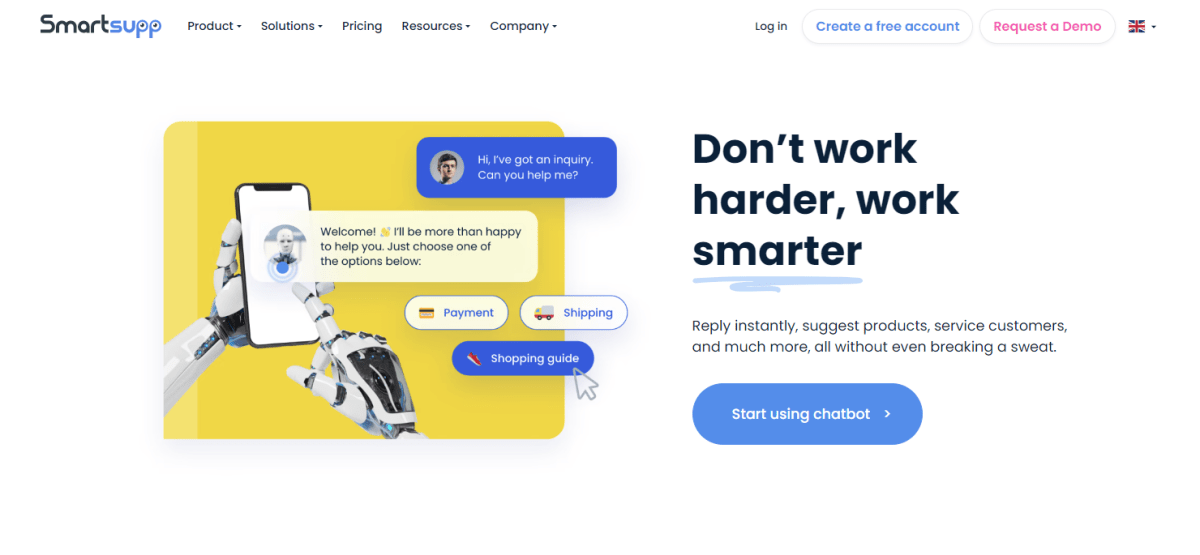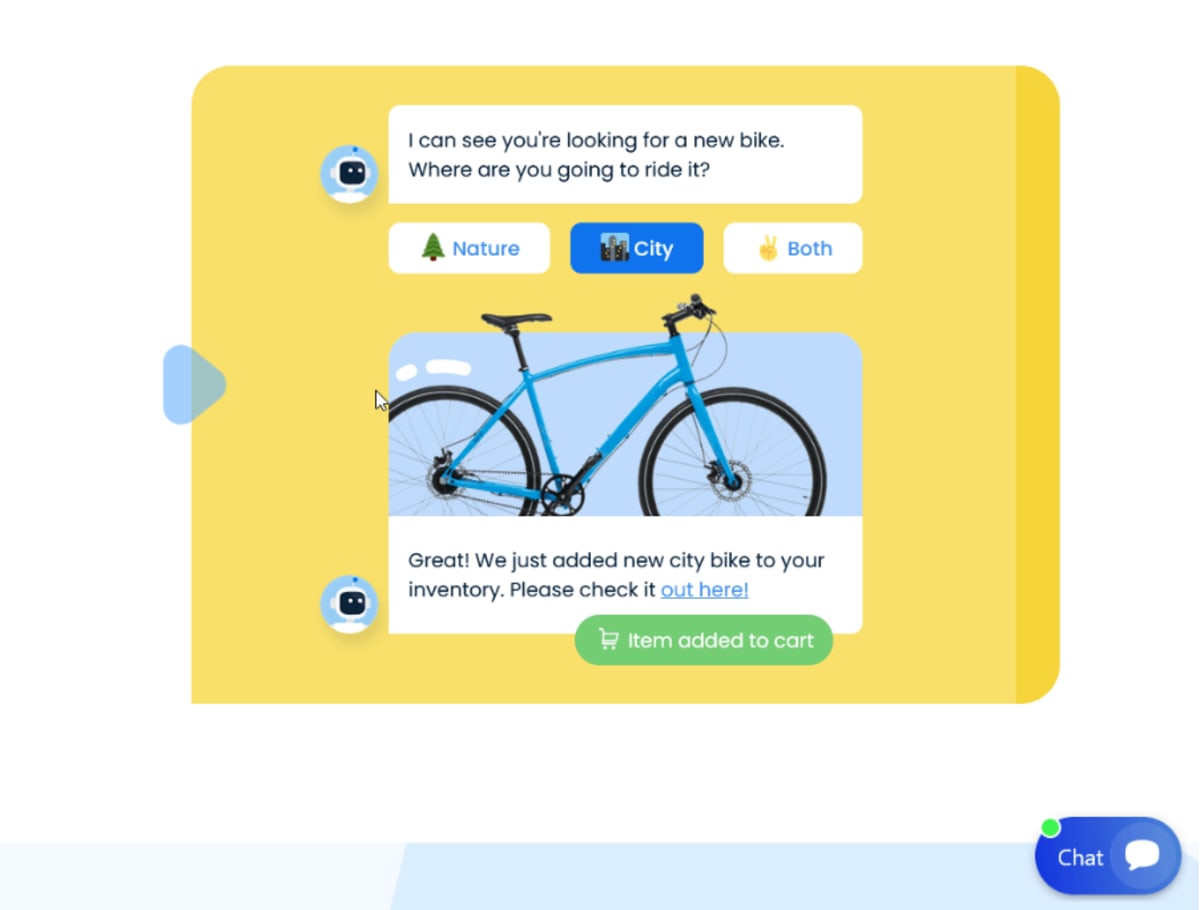In this guide, we will answer the question “what is a chatbot?”, discuss how they work, describe the many advantages they offer, and explain how you can build one to drive business growth.
Table of contents
Chatbot technology is continually growing in popularity as a method of automating customer service and support tasks. In this guide, we will answer the question “what is a chatbot?”, discuss how they work, describe the many advantages they offer, and explain how you can build one to drive business growth.
If you are wondering what a chatbot is and how it can benefit you, or are simply interested in learning more about this emerging technology, keep reading to find out everything you might need to know and more. By the end of this guide, you will be able to decide for yourself if chatbot technologies are right for your business.
What is a chatbot exactly?
A chatbot is a computer program that simulates human conversation through natural language understanding. Chatbots are used as digital assistants in a wide variety of settings, including online customer service, sales, marketing, and even GDPR compliance.
Chatbots can be used as automated programs for handling simple tasks like providing weather updates or setting reminders. They can also be used to handle more complex tasks like booking appointments or providing customer support.
No matter what their purpose is, all chatbots have one thing in common: they use various artificial intelligence (AI) technologies – natural language processing (NLP) and machine learning, for example – to interpret user intent from what they say or write and respond as human agents would do.
How do chatbots work?
Every chatbot, regardless of its purpose, uses artificial intelligence to interpret the user’s input and reply accordingly. In terms of how chatbots work, there are two main types of AI chatbots: rule-based and self-learning.
Rule-based chatbots
These rely on predetermined rules set by a human developer to determine how the chatbot will respond to certain inputs. As such, this type of chatbot is not very flexible and can only respond to specific questions or commands that it has been programmed to understand.
Self-learning chatbots
This type, on the other hand, relies on machine learning algorithms to understand how customers interact in order to become better at responding over time. Self-learning chatbots are much more flexible and can handle more complex tasks than rule-based chabots, but the former require more data to train on before they can become effective.
Both rule-based and self-learning chatbots have to be trained first, either according to the rules set programmed by the developer or through data from customer interactions, respectively.
Types of chatbots
With regards to their functionality, there are three main types of chatbots: task-oriented, conversational, and hybrid bots.
Task-oriented bots
This type is designed to help users complete specific tasks like booking appointments or making reservations. Because of that, task-orientated bots are particularly useful for any business (e.g. a restaurant) in the hospitality industry.
They are typically deployed on messaging platforms like SMS or popular chat applications such as Facebook Messenger and WhatsApp. The bot will appear there as a contact within the platform’s interface and users can start conversing with it just as they would with any other contact.
Conversational bots
Designed to mimic how human agents talk, this type is typically deployed on websites via chat windows or pop-ups and labeled digital assistants, customer service agents, or sometimes virtual assistants.
Conversational bots can answer questions about products or services (e.g. sharing a restaurant’s a-la-carte menu), provide customer support, and even upsell or cross-sell clients on additional products or services. Many businesses use conversational bots as an alternative to hiring human customer service reps.
Hybrid bots
As the name suggests, these are a combination of both task-oriented and conversational chatbots. Hybrid bots are designed to handle more complex tasks that require both types of chatbots working together.
For example, a hybrid chatbot system could be used to help visitors to the website of a restaurant book appointments and then attempt to upsell them by suggesting a set tasting menu with wine pairings.
The importance of chatbots for businesses
According to studies, 82% of consumers say that receiving immediate replies to their queries is crucial when contacting businesses. One way for businesses to meet that requirement is implementing chatbots to give instant responses to queries in order to reduce customer wait time.
As such, there are several clear benefits that make using chatbots important for businesses:
Improved customer experience
Automated chatbot technology helps businesses provide a fast and convenient way for potential and existing clients to get the answers they need. This results in a better user experience for them that is more likely to meet high customer expectations and, in turn, lead to improved customer satisfaction.
Increased sales
The previous advantage of chatbots for businesses means that they also have the potential to improve conversion rates. More satisfied customers are more likely to buy products or services from a company, show customer loyalty to the brand, and keep returning to do repeat business – meaning more revenue in the long run.
Reduced operating time and costs
Chatbots can help businesses improve operational efficiency and bring cost savings by automating tasks that would otherwise require human intervention, such as customer support or scheduling appointments. This is particularly useful for companies with round the clock customer service needs, which nowadays could be any that serves customers in multiple time zones.
The benefits of chatbots for customers
Considering that 90% of people are willing to talk with a chatbot for customer service if it will help them save time, this technology is evidently as popular for consumers as it is for businesses. There are several reasons why chatbots can be advantageous for customers:
Accessibility
The 24/7 customer services that chatbots offer is one of their most useful features. Customers can get immediate answers to their questions and queries at any time, without having to wait for a human operator to become available.
Many customers prefer to be able to solve the problems they are facing by themselves without having to ask another person for help, and chatbots that offer a self-service option are one method to effectively facilitate that. What’s more, you can program a chatbot in multiple languages so that it is accessible to customers from different locations.
Objectivity
Chatbots are not influenced by emotions, so they can provide customers with objective information and support. It doesn’t matter if a user is angry or even threatening, a chatbot will still “happily” handle any query so long as it can understand the user’s request – and that part is still a requirement for a human agent.
This is in contrast to human customer service representatives, who are naturally more likely to become defensive when speaking with an irate user and possibly say something that could harm rather than soothe the situation.
Accuracy
A chatbot’s automated responses are not only fast but they’re also usually precise. This is thanks to the chatbot’s pre-programmed script, which chatbot developers design specifically in order to provide the correct information to users.
Of course, chatbots are not perfect and there will, of course, be a chance for human error to occur in chatbot platform development. However, this is not as big of a risk as with human agents, who are more likely to make mistakes when under pressure.
Personalization
Many chatbots are designed to offer a personalized customer experience based on the information they input. This could include anything from providing product recommendations to sending reminders about purchasing an item or service the potential customer showed an interest in.
This type of personalization is not always possible with human customer service teams, who would need incredible memories or all customer data from enterprise systems at hand to be able to tailor the experience for them.
Natural language processing and artificial intelligence
Some of the pieces of software are equipped with NPL. It is an applied artificial intelligence that allows bots to understand human language. So, you can use it for checking order status, communicating with customers like an agent, or helping you to automate some tasks.
Examples of chatbot use cases
There are endless possibilities for chatbots and how they can be used to improve businesses. Here are just a few specific examples of chatbots in action:
Lead generation
One of the most popular applications for chatbots is identifying potential external customers. Asking questions to and collecting information from chatbot users can help identify business leads for sales teams to follow up on.
This is especially useful for companies that rely heavily on inbound marketing, as chatbots can help to qualify leads before they are even passed on to the sales department.
Sales support
Assisting with requests from answering product questions to proactive service providing information about pricing and discounts can help move prospects along the customer journey down the sales funnel. This is especially effective for chatbots that are integrated with e-commerce platforms, as they can provide a seamless customer experience from start to finish.
Customer service
Chatbots can help users with anything from finding the right product to troubleshooting issues. This is one of the most common applications, since chatbots can handle a large volume of customer queries at once and be available 24/7.
In terms of customer service, chatbots can be used to handle anything from order confirmation and shipping updates, to processing returns and refund requests.
Collecting feedback
Gathering opinions is important for every business that wants to improve their products or services, customer support teams, and the overall experience. Bot analytics can be used to gather feedback by asking users questions and then storing their responses.
This is an efficient way to gain insights into what customers think about your business, as well as identify any areas that might need improvement.
IT service management
Chatbots can also be used internally to help employees with self-service assistance and to automate processes for handling routine tasks such as password updates and providing system status or outage alerts. Knowledge management can also be made available 24/7, allowing staff members to search for answers to common questions without needing to wait for IT support.
How to build your own chatbot
Now that you know all about chatbots and their many benefits, you’re probably already wondering how you can go about building one for your business. The good news is that chatbot development is not as difficult or time-consuming as you might think.
In order to create a rule-based chatbot, all you need is a list of questions and answers. This chatbot can then be simply deployed on your website or in messaging apps on mobile devices, for example.
For a more sophisticated self-learning chatbot, you will most likely need to use a chatbot development platform. There are a number of different one available that allow anyone, regardless of their technical skills, to create a chatbot without any coding.
One of the most popular chatbot development platforms is Smartsupp, which allows you to create a chatbot in minutes without any coding. Let’s take a look at how simple the process is with this solution.
Build a chatbot with Smartsupp
Smartsupp is the perfect choice for customer care and e-commerce, as well as anything else you feel like. Setting up a chatbot is really simple, and you don’t need any technical expertise at all.

➡️ First things first, you need to create an account. It takes only a few minutes for you to give some information like your email address, website, and name.
➡️ Then insert the code on your website – you can do this later as you prefer.
➡️ Once you’re ready with the account and inserting the code, click on the Robot icon and select +Add New**.** Choose a template for chatbot conversations or build them from scratch.
🎥 In case of any doubts, watch how to set up a Smartsupp chatbot.
How to design a chatbot conversation with Smartsupp?
There are many ways you can use a Smartsupp chatbot. Here are some suggestions, but feel free to use bots as you like.
#1 For your most frequently asked questions
Think of your customer’s most common questions to use in chatbot conversations. Then, write the answers to those questions. This way, you can save some time on answering FAQs.
#2 As a product or information filter
Your website visitors can use a chatbot to buy any product or service they need. Make your chatbot a shopping assistant that recommends products which website visitors might be interested in. As a result, buyers will be satisfied with the help they get and you can increase revenue.

#3 To stand out from the competition
Chatbot support gives you an advantage over your competitors. It is also a sign for website visitors that you want to provide continuous, round-the-clock customer service. With chatbot support, customers can get the necessary information whenever they need it.
How can Smartsupp benefit your business?
Here is how you and your customers can benefit from a Smartsupp solution.
Get to know your target audience better with video recordings
This is a great feature that tracks how website visitors move around and interact with your site. Moreover, you can identify any moments when they give up on purchasing or leave your site.
Build customer connections thanks to automatic messages
Website visitors can be sent such messages when certain conditions are met. For example, after a minute of them entering your website they can receive greeting messages, product recommendations, or information that you’re happy to help in case they need assistance – you name it.
Save time using artificial intelligence
Shoptet users can save plenty of time implementing the Smartsupp chatbot service. Their customers can immediately get informed about order status thanks to AI support. It’s a real game-changer because your customer team members won’t have to do that manually anymore.
Streamline your workflow with integrations
Smartsupp’s chatbot can connect many tools that you already use. For example, it can seamlessly integrate with your favorite CRM system. Thanks to such integrations, you can easily gather all data in one place and then analyze it in detail. A centralized database with your buyers’ information makes it easy for salespeople to see what products customers love and use this information for further marketing purposes.
Monitor and improve customer service by monitoring statistics
To see conversation statistics, all you need to do is to head your admin panel. There you’ll find the number of:
- visitors to whom a chatbot was displayed
- visitors who you sent a message to using a chatbot or clicked on one of the buttons
- visitors who interacted only by clicking a button but did not send a message
- visitors who sent a message via the chat box as a reaction to the displayed chatbot, but did not necessarily click on the chatbot button
With all of those metrics, this chatbot tool makes it easy to control how your customer service is doing and if it needs improvement. In addition, you can check the data for different time periods. For example, you can see statistics for the last week, month, or year.
Additionally, Smartsupp provides a live chat solution for even better customer support. You can see your agents’ performance on the dashboard as well. Chatting in real-time with website visitors is an excellent option for e-commerce and customers care in both small and big companies.
The list of benefits does not end here. Learn more about Smartsupp’s chatbot features and capabilities.
Conclusion
A chatbot is a powerful tool that can be used to improve many aspects of your business, bringing about multiple benefits for both you and your customers. From a customer service to a lead generation bot, this kind of virtual assistant can streamline various processes to save you time and money on customer support costs and other outgoings.
If you’re looking to build a chatbot to improve the customer experience and drive conversions, Smartsupp is one of the best available chatbot development platforms. Why not give our free 14-day trial a go today and see how a chatbot can help with your business growth?
Chatbot FAQs
What are some challenges of using chatbots?
The biggest difficulties with chatbots include properly understanding the input and providing absolutely correct answers to customer queries. However, as artificial intelligence technology continues to develop and natural language understanding improves, chatbots are only going to get better at interpreting user behavior.
How can I improve customer engagement with a chatbot?
If you want to grab and maintain users’ attention with your chatbot, design it in a way such that it mimics human interaction as closely as possible. This means giving your chatbot a personality and using natural language processing (NLP) so that it can understand user inputs in order to increase customer engagement levels.
How will chatbots impact the future?
Chatbots are expected to have a major impact on various industries in the coming years as they become more advanced and widespread. It is predicted that chatbots will eventually be able to match or even enhance human capabilities sufficiently to take over jobs such as customer service agents and sales reps, as well as save businesses billions of dollars every year.
What is the difference between a chatbot and a voice assistant?
They are both types of virtual assistants – a chatbot is a computer program that simulates human conversation on a website or messaging applications, while a voice assistant is a software program (e.g. Siri or Alexa) that responds to voice commands to perform certain tasks. While chatbots can be used with text or voice input, voice assistants are typically only used with voice input.


